Church of MO: 2002 Ducati 998 First Ride
Post-916 and pre-999, Ducati hit a sweet spot in the form of the 998. Still taking the form of Massimo Tamburini’s 1994 masterwork, but powered by the greatly evolved Testastretta V-twin that powered Troy Bayliss to the 2001 World Superbike championship, the 999 was the best of old and new, the apogee of the 916 curve. Well, now it’s just old. But you know what I mean.
Silverstone-shire-derby-flamoozle, England, 12 January 2002
Unbelievably, the 916 has been around since 1994. That’s way back in the time when Yamaha’s FZR1000 was still the big dog in the show rooms.
When released, the 916 didn’t revolutionize the sport bike sector, Honda had already done that with their Fireblade. What it did, however, is put that new definition of performance into perhaps the prettiest package of the decade. The 916 is still with us and it looks much the same as it did back in ’94. Most people generally agree that, almost ten years later, it looks up-to-date. The Ducati has enjoyed gradual updates year by year, and is still arguably at the top of its class.
Now that the history lesson’s over, what’s it like to ride? In a word, brilliant!
Yes, that’s it – BRILLIANT!
At this point I could save this file and end my report – anything said from now on is simply a variation of brilliant. But, OK, you probably haven’t ridden the bike so I’ll be sensible and run through this test from start to finish, starting with the engine.
This year, the entire 916 – sorry, it’s now the 998 range – benefits from the new Testastretta, or narrow head engine. This is the motor Troy Bayliss used to win the World Superbike title this year. It comes in three states of tune: 123 bhp for the 998, 136 for the 998S and a claimed 139 bhp for the limited edition customer racer, the 998R. The engine actually displaces 998ccs – hence the name!
The Ducati 916 range has enjoyed gradual updates year by year, and is still arguably at the top of its class.
On the track, it’s immediately apparent that in its latest guise, the engine is much more responsive low down than in previous incarnations. The standard 998 is still a little short of puff on top, a GSX-R1000 would laugh at its straight-line performance, but the stronger 139bhp 998R might silence the Suzuki’s chuckles. Torrents of torque make the bike very easy to ride. Even if you ham up the gears and exit a corner too far up the six-speed box, the bike will rescue you, pulling strongly from as low as 2,000rpm. It’ll pull from below that, but the power pulses from the two 500cc pistons swinging up and down in the 90-degree V create too much snatch in the drive train for anyone with mechanical sensitivities to try it for long.
The power’s build-up is linear and there’s no sudden power band to catch you out, but there is enough low-down grunt to break the rear tire’s traction in the damp or cold conditions that were prevalent during my track test at Silverstone. Early in the morning, when damp patches still littered many of the corners, I lit up the rear tire, sliding it full sideways as I exited a tight turn. It was a progressive slide and the bike kept itself in order as I rolled off the throttle gently. Thankfully, the rear hooked up again without drama when I got back on the power. There wasn’t even a hint of high side.
The new 998 is far quieter than the original 916; the engine, gear box, clutch and exhaust — they all produce less clatter and bellow this year. A refined Ducati? Hmmmmm. The relative lack of top end punch, and the fact that I had recently ridden a four-cylinder race bike with a cut-out set at something above 15,000rpm, meant I was hitting the rather severe rev limiter all too much. It cuts the engine so efficiently that the faster riders on the track started to use it as an impromptu quick-shifter! The gear box is smooth and precise and the clutch light and accurate. The bite point stayed in exactly the same place for the entire session. The engine seems much refined over early models, it’s far quieter than the original 916; the engine, gear box, clutch and exhaust – they all produce less clatter and bellow this year. A refined Ducati? Hmmm.
A powerful engine is all very well, but it needs a capable chassis to help get the power promised by that glorious V-Twin onto the ground and to keep it there. This is an area that the 916 series has always excelled in and this year is no different. While the standard 998 isn’t as exotically equipped as its 998R stablemate, it’s nonetheless plenty well equipped to cope with the 123 bhp on tap. The Brembo brakes are also a notch down from the trick race parts fitted to the R, but again, the bike stops without drama and without a great deal of effort at the lever.
Entering the turns at the end of both the fast front and back straights at Silverstone gave them a good test, which they passed with flying colors by providing consistent and dependable braking time and time again. There was no fade, no excess lever travel, no hint of sponginess – just plenty of progressive two-fingered braking power all day. Compare that to the disappointing feel of the early 916 brakes, and there’s even more evidence that the 916 is evolving well.
While the standard 998 isn’t as exotically equipped as its 998R stablemate, it’s nonetheless plenty well equipped to cope with the 123 bhp on tap. Suspension duties on the 998 are taken care of by a pair of Showa front forks, which are Titanium Nitride treated even on the standard 998. Ti’ Nitride is a super-slick coating that ensures the fork tubes don’t stick to the sliders under heavy use. The rear end is well-controlled by an excellent Ohlins shock. The front brake discs are thinner this year, lowering the weight hanging on the front wheel and thus making turn-in even quicker. Indeed, the little 998 (for it is a physically tiny motorcycle) turns in fast and holds a line with amazing tenacity. Not even the bumps and tarmac ridges at Silverstone could shake the bike, even on full throttle while laid over on the tires’ edges.
As with previous variations, set-up is critical and there was quite a difference in the way the various test bikes felt. The eight bikes available at the test had all been individually tweaked at a previous track session, so all the settings were different. On the softer set-ups there was quite a bit of wobble at the rear when changing direction hard, something that was completely absent on the bikes with a firmer set-up. This is very much an individual thing, but if you are serious about riding a bike like this hard, you’ll be well advised to get it properly set-up to match your riding style and location. I preferred the harder settings at the track. Out on the road, where outright performance isn’t that crucial, the softer settings are a better compromise between comfort and performance.Speaking of which, while I am sure the 998 will make a stunning road bike, there’s no denying that a machine like this is most at home on a track where its capabilities can be exploited to the fullest in relative safety. There are not many roads where you can lean the bike over onto its foot pegs and then power out of the turn with the rear end smoking and sliding. On the contrary, Silverstone has many places where such behavior is encouraged and, thankfully, unlikely to be interrupted by myopic Volvo pilots or highway patrol cars
The bike does stand a little when braked mid-turn, but a little extra pressure on the relevant stubby clip-on handlebar corrected this immediately.The front end on the Ducati is extraordinary. The level of grip and control from the front end is faultless, the front Pirelli gripping at the tarmac with amazing force. Even a ham-fisted application of brakes mid-turn when I realized I had drifted way off line failed to push the front. The bike does stand a little when braked mid-turn, but a little extra pressure on the relevant stubby clip-on handlebar corrected this immediately. In the final turn before the front straight, a long constant radius corner that really loads the front as you wind the throttle back to get drive for the main straight, you could actually feel the grip – as if the tire was in fact your hands. Superb. The OEM Pirelli Dragon’s really compliment the Ducati’s set-up.
Despite a hard day’s riding at Silverstone, I failed to reveal any significant faults on the 998. OK, the absolute fastest riders could get the rear to break grip and get very sideways mid-turn, although none of them fell off as a result, confirming that this is a bike thats controllable even at, or beyond, the limits. What it also revealed was that the new 998 is a real rider’s bike, a motorcycle meant to be used hard and used purely for fun.
This isn’t a get-to-work ride, although some owners will no doubt commute on theirs, possibly because they just have to ride it again and again! But the 998 is also far from being a banzai, balls-out motorcycle – it’s actually very refined. This all-around user friendly feel is relatively new on a Ducati, leading one of the testers to comment on how it was getting to behave more and more like a Honda VFR800, a comment that didn’t actually go down too well with the Ducati factory guys present! It’s true though, this is the smoothest and most civilized version of the 916 ever released. But don’t worry, they haven’t washed the soul out of the machine – no way. This is still every bit a Ducati eight valve Desmo twin. It can still make the hairs stand up on the back of your neck in time-honored Ducati style.
This all-around user friendly feel is relatively new on a Ducati, leading one of the testers to comment on how it was getting to behave more and more like a Honda VFR800, a comment that didn’t actually go down too well with the Ducati factory guys present!
There’s not a lot to run through as far as equipment is concerned, this is a road bike made from a race bike. If it ain’t needed, it ain’t fitted, so ‘accessories’ are restricted to stuff like a steering damper and a dual seat on the Biposto model. There’s the usual array of add-on parts, both from Ducati and from a host of companies that have grown up to serve the increasingly popular machines. They vary from performance to pretty parts, and a trip to any Italian motorcycle dealership or show will find you plenty of illustrations of just how far you can take ‘personalizing’ a Ducati.
There’s no denying that a machine like this is most at home on a track where its capabilities can be exploited to the fullest in relative safety. There are not many roads where you can lean the bike over onto its foot pegs and then power out of the turn with the rear end smoking and sliding.
Who would buy the 998? The seriously rich are probably going to want the more expensive (and more importantly to them, exclusive) 998R or S versions. Still, even for the cash-laden, owning an R isn’t an easy feat. Apart from the cost, there won’t be many about and most of them will end up in the hands of privateer racers. Those on a tight budget are likely to decide that the 998 is too dear, and settle for an, arguably equally capable Japanese four. The 998S isn’t that much further up the price scale than the standard 998, and it produces a useful amount of extra ponies from its higher tuned motor.
Then there’s the cheaper Aprilia V-Twins or even a Triumph triple to further muddy the water of decision. But the answer is simple, the 998 is going to be purchased by riders who want to experience the credibility, the exceptional thrill and the soulful experience of Ducati ownership – probably by those who have already owned a 916. Those who can’t or won’t stretch the extra few thousand for the S model will get all of vital Ducati ingredients with the standard 998. And whoever buys the 998 in any of its guises, if my impressions are anything to go by, then one thing is for certain – they wont be disappointed.
Spec SheetEngine Type V-Twin, 4 valve per cylinder Desmodromic, liquid cooled Capacity 998cc Bore x Stroke 100 x 63.5 mm Compression Ratio 11.4:1 Power 123 bhp @ 9750rpm Torque 96.9nm @ 8000rpm Gears 6 speed Clutch Hydraulic dry multi plate Chassis Frame: Tubular steel trellis Wheelbase: 1410 mm Rake: 23.5 x 24.5 Suspension: Front Showa fully adjustable upside-down forks Rear Ohlins fully adjustable monoshock Wheels: Front – Marchesini 3,50 x 17 Tire Pirelli Dragon 120/70 ZR 17 Rear – Marchesini 5,50 x 17 Tire Pirelli Dragon 190/50 ZR 17 Brakes: Front – 2 x Brembo 4 piston calipers, 2 x 320mm semi floating Rear – 1 x Brembo 2 piston caliper, 1 x 220mm disc UK OTR Price 998 10,450 998S 13,150 998R Not announced
More by John Burns



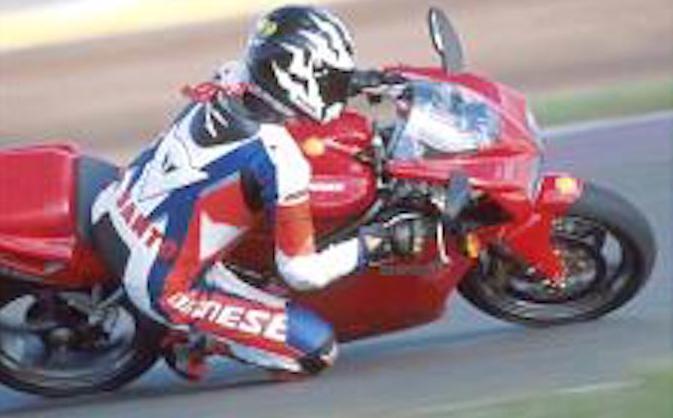















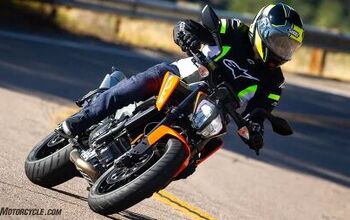
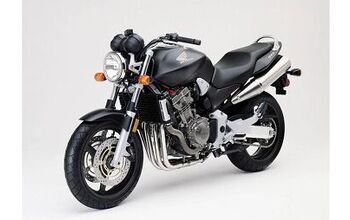

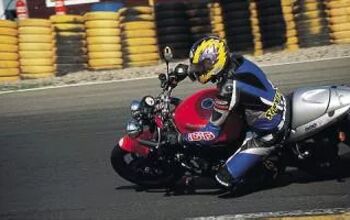
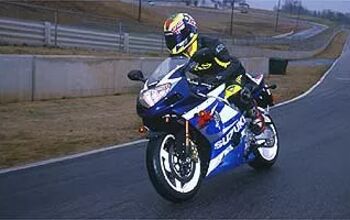











Comments
Join the conversation
The last gorgeous super bike from Ducati before Pierre Terblanche temporarily ruined the styling. Thankfully that was quickly rectified by the 1098. But this 916 series of Ducatis will always be legendary classics in my heart.
The 916 was a beauty of a bike, until you sat on it. I had many opportunities to buy one (used), but just couldn't reconcile the ergos. It's the reason I didn't buy a Ducati Sport Classic, just couldn't get past the ergos. And I don't regret that choice. I waited to check off the Ducati box with a 2014 Monster 796 ABS, which I still have, because I can ride it without suffering....well, except for when it's hot and those underseat pipes start BBQing the bits.